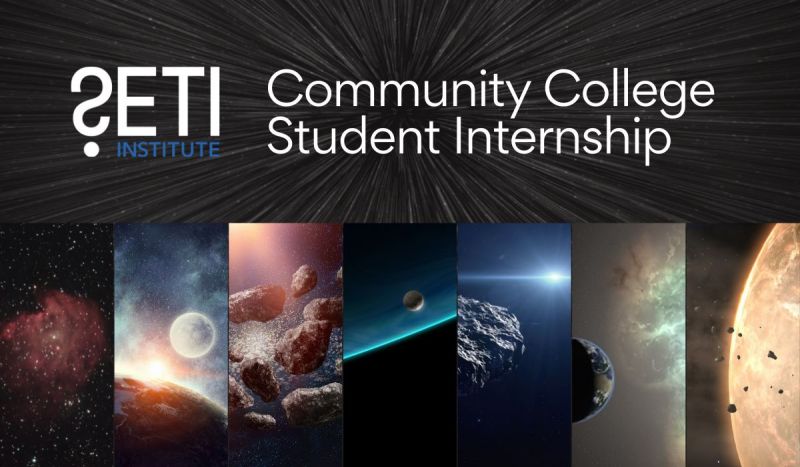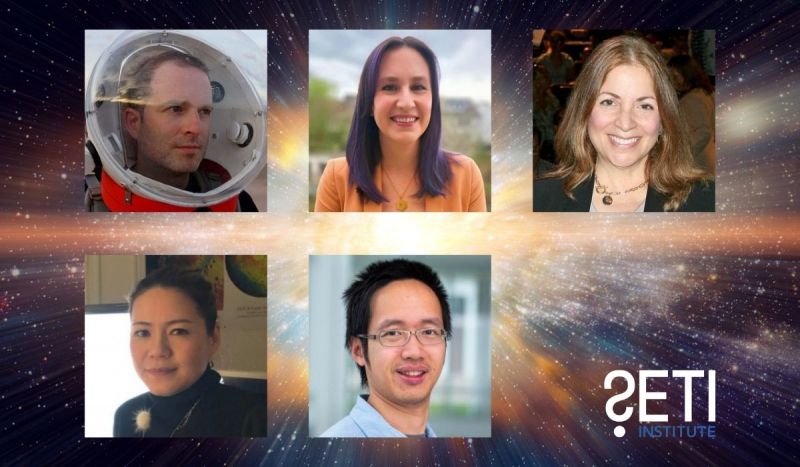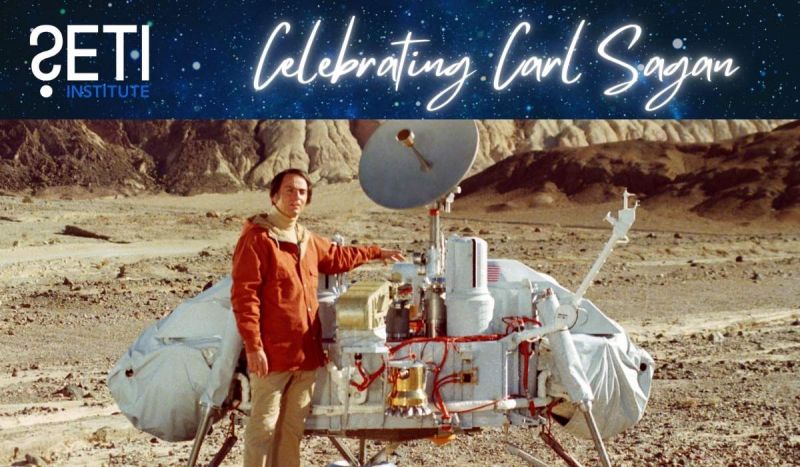
Is it aliens? Here's why it's hard to know for sure
Scientists continue to be excited about searching for life beyond Earth and consider both the benefits and costs. It’s not always a clear answer, but gathering more information brings about more questions and further research into how to get answers that will hopefully be fruitful over time.
“Unless there's a rabbit jumping in front of a rover — and we have to make sure it's not a robot — it's going to be difficult,” said Nathalie Cabrol, director of the Carl Sagan Center at the SETI Institute, a not-for-profit research organization dedicated to the search and study of extraterrestrial life.
Looking at the elements that make up the universe, Cabrol said everything is composed of energy (heat) and information (atoms). Taking a cue from how scientists in fields like neuroscience and artificial intelligence are approaching the topic, life at its simplest definition may just be the exchange of energy and information.
…So perhaps a more apt description for the search for extraterrestrial life would be the search for the manifestation of life’s diversity, Cabrol said, something that we would recognize as life based on our narrow perspective.
As scientists fine-tune their strategies, improve technologies, and put forth new ideas, we get closer to perfecting how we look for life on other planets. (Mashable)
- Mashable: Is it aliens? Here's why it's hard to know for sure.
- SETI.org: Carl Sagan Center for Research
 First 'space helicopter' set to take to Martian skies
First 'space helicopter' set to take to Martian skies
An “identified” flying object will soon grace the skies of Mars. Weighing in at a mere 4 pounds, Ingenuity, a helicopter-like drone carried to Mars by Perseverance, is scheduled to fly around Mars to photograph the Martian landscape and add another dimension to planetary exploration.
Planetary scientist Lori Fenton of the Search for Extraterrestrial Intelligence Institute (SETI) in California, who studies sand dunes on Mars and the challenges for robot Mars rovers, said she remembered a scientific proposal 12 years ago that suggested using a drone to study a field site somewhere in the western United States.
“[Some] panel members thought it was absurd that someone was requesting funding to use a ‘toy’ to do science,” she said. “Since then, the UAV industry has exploded, and here we are — about to land a drone on Mars that will do exactly the sort of reconnaissance that the review panel laughed at,” she said, referring to unmanned aerial vehicles. (NBC News)
- NBC News: First 'space helicopter' set to take to Martian skies
- SETI.org: Mars Perseverance
 Martian landslides may be caused by melting ice and salt under the surface
Martian landslides may be caused by melting ice and salt under the surface
Like SETI Institute senior research scientist Janice Bishop, scientists are looking for answers to what causes a landslide-like phenomenon on Mars. We don't have actual soil samples from Mars to study yet. Until we do, extreme terrestrial environments like those found in parts of Antarctica and the Atacama desert in Chile, seemingly analogous to Martian climate and terrain, provide researchers with clues as to what might be stirring beneath the surface on Mars that could contribute to the mysterious Recurring Slope Lineae (RSL).
…there is the mystery of Recurring Slope Lineae, known as RSL, that have intrigued scientists for years. These RSL are a form of landslide on Mars, but no one knows what causes them, said Janice Bishop, author of a new study on the phenomena.
"We see them from orbit by the dark streaks they produce on the ground and they tend to always occur on sun-facing slopes, which led geologists to think they were related to melting ice early on," said Bishop, senior research scientist at the SETI Institute in California.
"Antarctica and the Atacama are excellent analogs for Mars because they are ultra dry environments," Bishop said. "Antarctica has the added benefit that it is super cold. Parts of Antarctica including Beacon Valley are actually on par with Mars for temperature and aridity."
The researchers wanted to test if processes observed in places like Antarctica, where salty sediments can have an effect on surface soil, could be happening on Mars. (CNN)
…..
“The whole RSL story is complicated because we are not there and we can’t test it,” says Bishop. The rovers that have been on Mars can only dig a few centimetres under the surface, so can’t tell us anything about the possibilities of processes like the one Bishop and her colleagues suggest could cause RSLs.
However, the Rosalind Franklin rover, planned to launch in 2022, will have the capability to dig deeper, so it may be able to solve the mystery. (NewScientist)
- CNN: Martian landslides may be caused by melting ice and salt under the surface.
- NewScientist: Lines on Mars could be created by salty water triggering landslides
- Live Science: Cause of mysterious dark streaks on Mars found
- ScienceAlert: Could Mars' Landslides Be Caused by Underground Salt And Melting Ice?
- Universe Today: What’s Causing Those Landslides on Mars? Maybe Underground Salt and Melting Ice
- SETI.org: Martian Landslides Caused by Underground Salts and Melting Ice?
 Four New Exoplanets Orbiting a Nearby Sun-Like Star Discovered by TESS
Four New Exoplanets Orbiting a Nearby Sun-Like Star Discovered by TESS
Researchers, including Joseph Twicken, a SETI Institute scientist and co-author of TESS Discovery of a Super-Earth and Three Sub-Neptunes Hosted by the Bright, Sun-like Star HD 108236, have found evidence of new exoplanets in a nearby star system using data from TESS (Transiting Exoplanet Survey Satellite), an MIT-led NASA mission.
MIT researchers have discovered four new exoplanets orbiting a sun-like star just over 200 light-years from Earth. Because of the diversity of these planets and brightness of their star, this system could be an ideal target for atmospheric characterization with NASA’s upcoming James Webb Space Telescope. Tansu Daylan, a postdoc at the MIT Kavli Institute for Astrophysics and Space Research, led the study published in The Astronomical Journal on January 25, 2021.
With further study, says Daylan, this bright star and its many planets could be critical to understanding how planets take shape and evolve. (SciTechDaily)
Machine learning plays a significant role in scientific discovery by interpreting the massive amounts of data now available from TESS.
"The really useful feature of eclipsing binaries, and the reason that they are the backbone of astrophysics, is that they give us direct measurements of their fundamental properties, such as their mass and size," said Veselin Kostov, a research scientist at Goddard and the SETI Institute in Mountain View, California. "And through these properties, we can directly measure distances to these systems. They afford us one of the very few opportunities to measure direct distances in the universe."
Machine learning vastly improves the efficiency of finding these star systems in tens of millions of TESS images by learning to identify the features of an eclipse and labeling the light curve accordingly. (Phys.org)
- SciTechDaily: Four New Exoplanets Orbiting a Nearby Sun-Like Star Discovered by TESS
- Phys.org: Researcher uses machine learning to classify stellar objects from TESS data
- SETI.org: Exoplanets
 The SETI Institute Is Planning to Send Earth Music to Space Aliens
The SETI Institute Is Planning to Send Earth Music to Space Aliens
Microphones help amplify the human voice beyond its innate ability to project sound out of the body. Now scientists and artists are teaming up to send the human voice out even farther – into space. SETI Artist-in-Residence Felipe Pérez Santiago is creating original compositions from voices gathered through the Earthling Project app to be sent to the moon and beyond as a representation of Earth and reminder of home to astronauts venturing out into the cosmos.
The Search for Extra-Terrestrial Life Initiative – known simply as SETI – are about to embark on a mission to send music from our pale blue dot into outer space in the hopes of grabbing the attention – or repulsion, depending on the music – of extra-terrestrial life.
The Earthling Project, which collects songs from people across the world to create musical compositions and send them into space, officially launched in December of last year.
Dr. Jill Tarter, co-founder of the SETI Institute, has said that she is “excited to see/hear what Felipe and his team can create.”
“I love the idea of composing music based on songs from around the planet, a piece of music that astronauts can someday take with them to distant worlds to remind them of home.” (The Latch)
- The Latch: SETI Is Planning to Send Earth Music to Space Aliens
- Explica: The Earthling Project will bring voices from around the world to space
- SETI.org: Earthling Project Launches
- SETI.org: SETI Institute Artists in Residence Program
 Progress, Potenial, and Possibilities: Dr. Jill Tarter - Chair Emeritus - SETI Institute
Progress, Potenial, and Possibilities: Dr. Jill Tarter - Chair Emeritus - SETI Institute
Dr. Jill Tarter joins host Ira Pastor as a guest on the show Progress, Potential and Possibilities for a discussion about her work in SETI, the search for extraterrestrial intelligence.
- YouTube: Dr. Jill Tarter - Chair Emeritus - SETI Institute - The Search for Extraterrestrial Intelligence
- SETI.org: Jill Tarter
 The $3,000 eVscope makes stargazing easy and fun
The $3,000 eVscope makes stargazing easy and fun
Stargazing enthusiasts are testing Unistella’s eVscope in polluted and non-polluted areas to see if it measures up to their promise to see the night sky clearly from anywhere.
Unistellar's eVscope promises great stargazing whether you're in the city or country. (Ars Technica)
As the asteroid Apophis comes in closer to Earth for easier viewing in early March, citizen scientists join professional astronomers in aiming their telescopes to catch a glimpse.
"With the demise of the Arecibo telescope, it has become more difficult to accurately measure the position of asteroids during a flyby," explains Franck Marchis, senior astronomer at the SETI Institute and chief scientific officer at Unistellar, which sells an autonomous smart telescope, eVscope. Marchis is encouraging eVscope owners to help observe Apophis later this month. (CNET)
- Ars Technica: The $3,000 eVscope makes stargazing easy and fun
- CNET: Apophis, the most intimidating asteroid around, is coming in for a visit
- SETI.org: Unistellar Network
Big Picture Science
 Granting Immunity
Granting Immunity
“Diversity or die” could be your new health mantra. Don’t boost your immune system, cultivate it! Like a garden, your body’s defenses benefit from species diversity. Find out why multiple strains of microbes, engaged in a delicate ballet with your T-cells, join internal fungi in combatting disease. Plus, global ecosystems also depend on the diversity of its tiniest members; so what happens when the world’s insects bug out?
Join guests Matt Richtel, Rob Dunn, David Underhill and Anne Sverdrup-Thygeson for a discussion about what bolsters the body’s immune system as well as how this is reflected in the global ecosystem in Granting Immunity.
 Mars Attracts
Mars Attracts
Earth invades Mars in February. In a historic trifecta for space exploration, spacecraft of three countries will arrive at Mars, and for two of those it will be their first time at the Red Planet. We talk to the science lead for the Emirates Mars Mission, a NASA engineer piloting the first helicopter on Mars, and a British space expert – all to learn how these spacecraft may bring greater understanding of this rusty world – including whether Mars ever supported life.
Join guests Sarah Cruddas, Sarah Al Amiri and Håvard Grip as they discuss the convergence of three exploratory efforts on Mars lead simultaneously by three different countries in Mars Attracts.
 Iron, Coal, Wood: How They Changed Everything
Iron, Coal, Wood: How They Changed Everything
Maybe you don’t remember the days of the earliest coal-fired stoves. They changed domestic life, and that changed society. We take you back to that era, and to millennia prior when iron was first smelt, and even earlier, when axe-handles were first fashioned from wood, as we explore how three essential materials profoundly transformed society.
We were once excited about coal’s promise to provide cheap energy, and how iron would lead to indestructible bridges, ships, and buildings. But they also caused some unintended problems: destruction of forests, greenhouse gases and corrosion. Did we foresee where the use of wood, coal, and iron would lead? What lessons do they offer for our future?
Join guests Jonathan Waldman, Ruth Goodman and Roland Ennos as they look at the benefits and costs of iron, coal and wood use throughout history in Iron, Coal, Wood: How They Changed Everything.
For more information and the archive of past shows, visit the Big Picture Science website.
SETI Live
Recent SETI Live episodes include:
 What's Causing Landslides on Mars? SETI Institute senior research scientist Janice Bishop has a theory. Based on observations from the Mars Reconnaissance Orbiter, fieldwork at terrestrial Mars analog sites, and lab experiments, Bishop and her team believe that small-scale ice melting in the near-surface regolith is causing changes at the surface that make it vulnerable to dust storms and wind. Join us for a conversation with Janice to learn more.
What's Causing Landslides on Mars? SETI Institute senior research scientist Janice Bishop has a theory. Based on observations from the Mars Reconnaissance Orbiter, fieldwork at terrestrial Mars analog sites, and lab experiments, Bishop and her team believe that small-scale ice melting in the near-surface regolith is causing changes at the surface that make it vulnerable to dust storms and wind. Join us for a conversation with Janice to learn more.
 Sextuply-Eclipsing Sextuple Star System -- WHAT? Last month a team of researchers, including the SETI Institute's Veselin Kostov, announced they had uncovered a unique 6-star system in TESS data, with the help of AI. The three binary stars form a gravitationally-bound system and each pair is producing eclipses. That's six eclipses! What can this system teach us about star formation and why does it matter? Join us in conversation with Veselin to learn more!
Sextuply-Eclipsing Sextuple Star System -- WHAT? Last month a team of researchers, including the SETI Institute's Veselin Kostov, announced they had uncovered a unique 6-star system in TESS data, with the help of AI. The three binary stars form a gravitationally-bound system and each pair is producing eclipses. That's six eclipses! What can this system teach us about star formation and why does it matter? Join us in conversation with Veselin to learn more!
As always, videos of all past Facebook Live events can be found on our Facebook page: https://www.facebook.com/SETIInstitute/
Or on our YouTube channel: https://www.youtube.com/SETIInstitute





